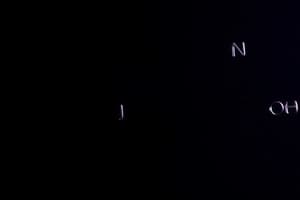Podcast
Questions and Answers
Which of the following carbocations exhibits the highest stability?
Which of the following carbocations exhibits the highest stability?
- A carbocation with three benzene rings.
- Tropylium ion. (correct)
- A carbocation with five alpha hydrogens.
- A carbocation with two benzene rings.
In which of the following scenarios is a square pyramidal shape most likely to be observed?
In which of the following scenarios is a square pyramidal shape most likely to be observed?
- A molecule with a steric number of 5 and one lone pair.
- A molecule with a steric number of 4 and no lone pairs.
- A molecule with a steric number of 6 and two lone pairs.
- A molecule with a steric number of 6 and one lone pair. (correct)
Consider a reaction sequence where an alkyl halide reacts with KCN and then with $AgNO_2$. What are the expected major products?
Consider a reaction sequence where an alkyl halide reacts with KCN and then with $AgNO_2$. What are the expected major products?
- Alkyl cyanide followed by a nitroalkane. (correct)
- Alkyl cyanide followed by an alkyl nitrite.
- Alkyl isocyanide followed by a nitroalkane.
- Alkyl isocyanide followed by an alkyl nitrite.
What is the number of lone pairs on the central atom in $ClF_3$, and how many unpaired electrons are there in the vanadium atom with a $d^3$ configuration?
What is the number of lone pairs on the central atom in $ClF_3$, and how many unpaired electrons are there in the vanadium atom with a $d^3$ configuration?
In a Borax bead test, which metal ion is responsible for a violet color under hot conditions?
In a Borax bead test, which metal ion is responsible for a violet color under hot conditions?
Which of the following orders of atomic radii is INCORRECT considering periodic trends?
Which of the following orders of atomic radii is INCORRECT considering periodic trends?
Consider elements from Group 13. How would you determine the most stable oxidation state based on their first ionization enthalpies?
Consider elements from Group 13. How would you determine the most stable oxidation state based on their first ionization enthalpies?
What is the value of $\Delta T_f$ (freezing point depression) if the molar mass is 256 g/mol and the constant involves a factor of 1/256 with a solution of 50 x 10^-3 kg?
What is the value of $\Delta T_f$ (freezing point depression) if the molar mass is 256 g/mol and the constant involves a factor of 1/256 with a solution of 50 x 10^-3 kg?
Chlorobenzene is converted to phenol via the Dow process. The product is then reacted with $NaCN$. Finally, a reaction with $CO_2$ follows. What are the end products of this series of reactions?
Chlorobenzene is converted to phenol via the Dow process. The product is then reacted with $NaCN$. Finally, a reaction with $CO_2$ follows. What are the end products of this series of reactions?
Which of the following reactions can both aldehydes and ketones NOT undergo?
Which of the following reactions can both aldehydes and ketones NOT undergo?
Which pair of quantum numbers, when applied to an electron, would likely result in the same energy level?
Which pair of quantum numbers, when applied to an electron, would likely result in the same energy level?
For a weak acid, which equation correctly relates pH to pKa and concentration (c)?
For a weak acid, which equation correctly relates pH to pKa and concentration (c)?
What general trend is observed in the graph of molar conductance ($\Lambda_m$) versus the square root of concentration ($\sqrt{c}$)?
What general trend is observed in the graph of molar conductance ($\Lambda_m$) versus the square root of concentration ($\sqrt{c}$)?
In the context of oxidation reactions, which of the following transformations represents the oxidation of $SO_3$?
In the context of oxidation reactions, which of the following transformations represents the oxidation of $SO_3$?
Which of the following reagents is commonly used as a Grignard reagent?
Which of the following reagents is commonly used as a Grignard reagent?
Given numbers 0, 1, 2, 3, 4, 5, 6, and 7, how would you compute the number of possible 5-digit numbers greater than 50,000 where the sum of the digits is less than a certain value?
Given numbers 0, 1, 2, 3, 4, 5, 6, and 7, how would you compute the number of possible 5-digit numbers greater than 50,000 where the sum of the digits is less than a certain value?
In the evaluation of a function involving $f(1+x)$, what strategy is essential for correct handling?
In the evaluation of a function involving $f(1+x)$, what strategy is essential for correct handling?
When performing the integration of $x^2 \cdot cos(x)$, what is the most efficient method to apply?
When performing the integration of $x^2 \cdot cos(x)$, what is the most efficient method to apply?
When addressing a question involving both a mode function and modulus sign, what key concept is crucial?
When addressing a question involving both a mode function and modulus sign, what key concept is crucial?
How do you generally simplify the expression $\frac{nCr-1}{nCr}$?
How do you generally simplify the expression $\frac{nCr-1}{nCr}$?
Flashcards
Tropylium Ion
Tropylium Ion
A very stable carbocation due to delocalization of the positive charge over the ring.
Square Pyramidal Shape
Square Pyramidal Shape
A molecular shape with the central atom at the apex and four ligands forming the base of a pyramid.
SN2 Reaction Products
SN2 Reaction Products
SN2 reaction favors attack at the carbon atom, whereas with covalent conditions nitrogen attacks SN2.
Lone Pairs
Lone Pairs
Signup and view all the flashcards
Borax Bead Test
Borax Bead Test
Signup and view all the flashcards
Atomic Radii
Atomic Radii
Signup and view all the flashcards
Ionization Enthalpy
Ionization Enthalpy
Signup and view all the flashcards
Delta TF
Delta TF
Signup and view all the flashcards
Coalbe Reaction
Coalbe Reaction
Signup and view all the flashcards
Cannizaro
Cannizaro
Signup and view all the flashcards
"N + 1" Rule
"N + 1" Rule
Signup and view all the flashcards
pH of a Weak Acid
pH of a Weak Acid
Signup and view all the flashcards
Molar Conductance vs. Concentration
Molar Conductance vs. Concentration
Signup and view all the flashcards
Oxidation Reaction Types
Oxidation Reaction Types
Signup and view all the flashcards
Grignard Reagent
Grignard Reagent
Signup and view all the flashcards
Integration by Parts
Integration by Parts
Signup and view all the flashcards
Arg z-1 Z2 Side Triangle Area
Arg z-1 Z2 Side Triangle Area
Signup and view all the flashcards
Image Questions
Image Questions
Signup and view all the flashcards
Beta Disintegration
Beta Disintegration
Signup and view all the flashcards
Y DSC Question
Y DSC Question
Signup and view all the flashcards
Study Notes
शिफ्ट टू पेपर एनालिसिस
- Paper analysis indicates no significant variation from the complete chemistry revision
- Candidates for shift two can approach the exam confidently
- Join the 30th batch for a serious second attempt and advanced studies
Second Attempt and Advanced Studies Batch
- The batch emphasizes dedicated work and intense practice
- Coaching depends on deep dedication
Question 1: Carbocation Stability
- Focus on carbocation stability from previous revision
- Features tropylium ion
- Tropylium ion is the most stable
- Stability order: tropylium ion, three benzene rings, two benzene rings, five alpha hydrogens
Question 2: Square Pyramidal Shape
- Square pyramidal shape occurs in steric number six with one lone pair
- The shape can be observed in coordination compounds and chemical bonding
- Example: BRF5
- Brf5 has a steric number of six with one lone pair
Question 3: Products A and B in Reaction
- Discusses the products formed under different reaction conditions
- Focuses on SN2 attacks
- Nitrogen, sulfur, and carbon attract in covalent bonds
- KCN present in ionic bonds
- Ionic configuration produces CH3 CH2 CH2 combined with CN
- Covalent bonds produce CH3 CH2 CH2
- Nitrogen attacks the SN2 and releases the BR
- BR is picked up by AG as precipitate to generate CH3 CH2 NO2
Question 4: Number of Lone Pairs on the Central Atom
- Determining the number of lone pairs on the central atom
- "n" is designated as the number of lone pairs
- CLF3 structure dictates that n = 2; there are two lone pairs
- Vanadium configuration D3 indicates three unpaired electrons
Question 5: Borax Bead Test
- Violet color is due to manganese at +2 oxidation state
- Nickel is +2 in the violet state; it is not as hot as manganese
Question 6: Incorrect Decreasing Order of Atomic Radii
- Identifying the incorrect order of atomic radii
- Requires knowledge in atomic structure
- Requires understanding the relationship between the third and second period elements
- Understanding contraction with the third period's atomic radii is needed
- Must understand third vs second period competition
Question 7: Most Stable Oxidation State of Element with Highest and Lowest First Ionization Enthalpies
- Group 13 ionization energy is highlighted
- Highlights unique questions
- Focuses on group 13 elements
- Details the relationship between ionization energy and atomic numbers
- Must compare high vs low ionization energies
Question 8: Calculation Involving Delta TF
- Calculation involves working with the molar mass relationship
- Key variables include 256, 1/256, 50 x 10-3
Question 9: Identifying End Products in a Series of Reactions
- Several reagents are introduced, and the products will need to be determined
- Chlorobenzene converts to phenol via the Dows process
- Phenol converts to phenoxide in the presence of KN
- Phenoxide produces a Coalbe reaction after the carbon attacks the CM minus to the CO2
- Final products: Salicylic acid, amide, and isocyanide
Question 10: Properties of Aldehydes and Acetones
- Examines various reactions that both aldehydes and acetone can undergo
- Key reactions include tolerance test, iodoform, edol and cannizaro
- Neither of them perform a cannizaro reaction
Question 11: Quantum Numbers having Same Energy
- "N + 1" Rule
- N + 1 value is different among alternatives except C & D
Weak acids pH and pka relation
- Valid equation for week acide: h plus equal squared cka
- ph= -logh+=-log sq cka = (1/2) (PKa-logc)
Lambda M and root under C
- Molar conductance and root under c: graph nature
Question KMN 4 & K2 C2 O7; type of oxidation reaction
- I- to i2
- i- to io3 minus
- fe+2- fe +3
- oxidation reaction SO3 to S
Question Reagent
- Gringard
Set Number of 5 Digit Number
- Greater than number of 5,000 using numbers 0123 ,45,6,7
- What's the sum will be less than
Question F And 1 Plus
- Remember to check f1+x
Integration with X squared and cos x
- Integration with king's roles
- Apply bypass twice to get x squared plus cos x
- Apply by Parts 2 Times
Question With Mode Key And Modulus Sign
- Mod and modulus sign in a question
Ncr -1 divided by ncr
- NCr minus one divided by Ncr standard
Arg z-1 Z2 Side Triangle Area
- Argument between Z1 and Z2 has an area of triangle.
Point Trepidation
- Vertices on the parabola
Question Imaged
- Image questions use 3D equations where you have to find a point and draw a perpendicular
Point the Circle Touch the Axis
- Questions on key concept where the circle touches the access A0 have a simple equation and relationship
Side inverse question
- Convert inverse trigonometry sin/ cos to get to pythagorean
Beta disintegration
- Check the new particle emitted in data disintegration
Y DSC y Double split experiment question
- Young's double split experiment Y DSC is a direct form question
The Prime Question
- 2/5 and *35
Studying That Suits You
Use AI to generate personalized quizzes and flashcards to suit your learning preferences.



